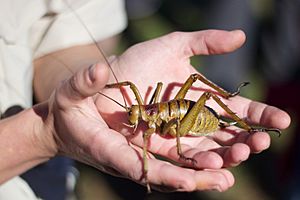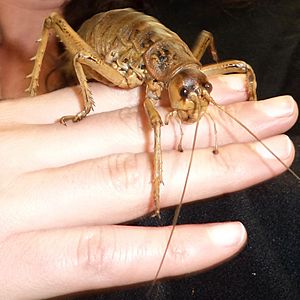Giant wētā facts for kids
Quick facts for kids Giant wētā |
|
|---|---|
 |
|
| Wētāpunga (Deinacrida heteracantha) – its body and legs can stretch up to 20 cm (8 inches) | |
| Scientific classification |
|
| Kingdom: | Animalia |
| Phylum: | Arthropoda |
| Class: | Insecta |
| Order: | Orthoptera |
| Suborder: | Ensifera |
| Family: | Anostostomatidae |
| Subfamily: | Deinacridinae |
| Genus: | Deinacrida White, 1842 |
| Species | |
|
See text |
|
Giant wētā are a group of very large insects that live only in New Zealand. They are part of the genus Deinacrida, which is a type of wētā. Most of the eleven species of giant wētā are protected by law because they are rare and in danger of disappearing forever.
Giant wētā are some of the heaviest insects in the world. The biggest ones can grow up to 7 cm (3 in) long, not including their legs and antennae. They usually weigh no more than 35 g (1.2 oz). One female in captivity weighed about 70 g (2.47 oz), which is heavier than a sparrow! However, this was unusual because she was carrying a very large number of eggs.
The name Deinacrida comes from Ancient Greek and means "terrible grasshopper." Despite their name, they are usually gentle and less social than other wētā. They once lived all over New Zealand, but now they are mostly found on smaller islands where there are no predators like rats or cats.
Contents
Where Do Giant Wētā Live?

Giant wētā need safe places to live, away from predators that were brought to New Zealand by people. Most of their populations have shrunk because of these new animals and because their natural homes have been destroyed.
There are different types of giant wētā, and they live in different places.
- Tree Dwellers: Three species live in trees in the north of New Zealand. They can now only be found on islands that are free of mammals, like Te Hauturu-o-Toi (Little Barrier Island) and the Poor Knights Islands.
- Ground Dwellers: Two species live closer to the ground. The Cook Strait giant wētā (Deinacrida rugosa) lives on protected islands, and the Kaikōura giant wētā (D. parva) is found near Kaikōura in the South Island.
- Mountain Specialists: Five species live high up in the mountains of the South Island. The scree wētā (D. connectens) lives about 1,200 m (3,900 ft) above sea level. It can even survive being frozen solid when temperatures drop below −5 °C (23 °F)!
Types of Giant Wētā
There are eleven known species of giant wētā:
- Deinacrida carinata (Herekopare wētā)
- Deinacrida connectens (Scree wētā)
- Deinacrida elegans (Bluff wētā)
- Deinacrida fallai (Poor Knights giant wētā)
- Deinacrida heteracantha (Little Barrier Island giant wētā or wētāpunga)
- Deinacrida mahoenui (Mahoenui giant wētā)
- Deinacrida parva (Kaikōura giant wētā)
- Deinacrida rugosa (Cook Strait giant wētā)
- Deinacrida pluvialis (Mt Cook giant wētā)
- Deinacrida talpa (Giant mole wētā)
- Deinacrida tibiospina (Mt Arthur giant wētā)
Life Cycle and Reproduction
Giant wētā usually live by themselves. When it is time to reproduce, males will travel around to find females. For some species, like the scree wētā, males that can move around the most are more successful at finding mates.
In many giant wētā species, males and females look different. This is called sexual dimorphism. For example, males often have longer legs and lighter bodies, which helps them cover more ground when searching for a female. Bigger males may also have an advantage in pushing smaller rivals away.
Unlike many insects, giant wētā do not seem to have fancy courtship displays. Instead, a male and female pair may stay together and mate several times. There is not much information about whether giant wētā parents care for their young. However, in similar insect groups, females are known to guard their eggs.
What Do Giant Wētā Eat?
Although they look a bit like mice, giant wētā have a very different diet. Most wētā are omnivores, meaning they eat both plants and other animals. However, the largest giant wētā are usually herbivores, which means they only eat plants.
The scree wētā has been seen eating small fruits. After eating the fruit, they help spread the seeds to new places. This shows that giant wētā play an important role in their ecosystem.
How Do Giant Wētā Communicate?
Giant wētā have a special way of communicating. Instead of making sounds you can hear, they use vibrations. A male Cook Strait giant wētā will vibrate its body up and down very quickly. This is called tremulation.
These vibrations travel through the ground, leaves, and bark. It is a way for a male to warn other males to stay away, especially if a female is nearby. The male that starts vibrating first often has a better chance of mating. This type of communication is common in the insect group that wētā belong to, called Orthoptera.
Dangers to Giant Wētā
For millions of years, New Zealand's native animals evolved without any land mammal predators, except for two species of bats. This meant that many birds and insects, including the giant wētā, did not need to fly to escape danger.
When people arrived in New Zealand, they brought new animals with them. These new arrivals, along with changes to the environment, have become major threats to the giant wētā.
| Threat | Description | Impact |
|---|---|---|
| New Predators | Animals brought from other countries, like cats, rats, stoats, and dogs, hunt giant wētā. | Giant wētā are large, slow, and cannot fly, making them easy prey for these new predators. |
| Losing Their Homes | Forests and natural areas are cleared for farms, cities, and roads. This is called habitat destruction. | When their homes are destroyed, wētā have nowhere to live, find food, or lay their eggs. This causes their populations to shrink. |
| Climate Change | The warming of the planet caused by human activity is changing the environment. | Rapid temperature changes can affect when wētā reproduce and what food is available for them to eat. |
| Competition from Other Insects | New insect species brought to New Zealand might compete with giant wētā for food and shelter. | If there is not enough food or space to go around, the native giant wētā can be pushed out. |
Helping Giant Wētā Survive
Conservation groups in New Zealand are working hard to protect giant wētā. Their efforts focus on controlling predators and protecting the places where wētā live.
The Mahoenui Giant Wētā's Surprising Home
In 1962, a small group of Mahoenui giant wētā, which people thought were extinct, was discovered. They were living safely inside a large patch of gorse, a spiky plant that was brought to New Zealand.
The sharp spines of the gorse bush protected the wētā from predators. The gorse also provided food and shelter. This area is now a special reserve where the wētā, the gorse, and even the local goats that help spread the gorse seeds are all protected.
Saving the Wētāpunga
The largest giant wētā, the wētāpunga, lives on Te Hauturu-o-Toi (Little Barrier Island). This island is a nature reserve and has been kept free of pests like rats.
To make sure the wētāpunga species survives, some have been carefully moved to other predator-free islands, like Tiritiri Matangi and Motuora. These new populations act as a backup, just in case something happens to the main group on Little Barrier Island.
The Future of Giant Wētā
The future of the giant wētā depends on keeping their island homes safe and controlling predators on the mainland. By creating more predator-free areas, it may one day be possible to bring giant wētā back to parts of New Zealand where they have not been seen for a long time. Teaching the public about these amazing insects is also key to protecting them for future generations.

